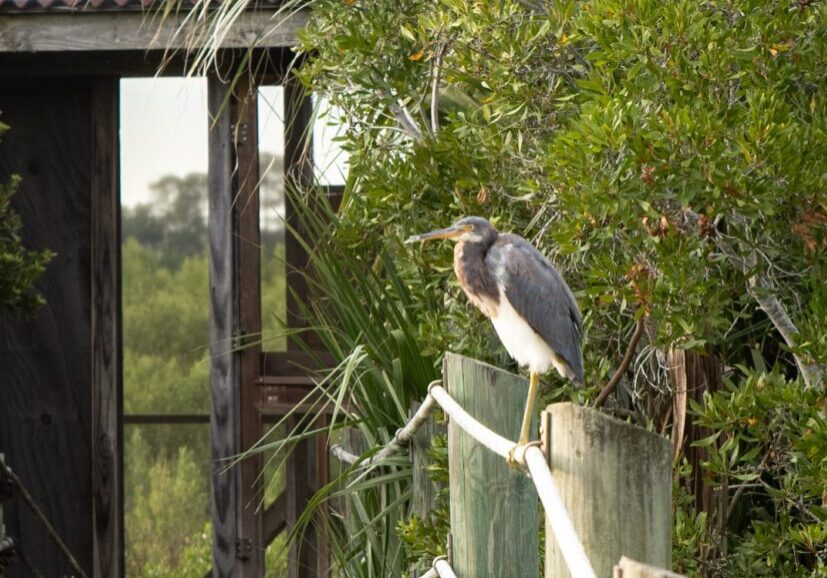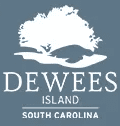The Island Lifestyle
Living on Dewees is a unique experience best suited for those who thrive on simplicity and a connection to the environment. While the island provides many modern comforts, it embraces a peaceful retreat from the fast-paced energy of city life.
For those ready to embrace this rare opportunity, Dewees offers an unparalleled island experience. Whether building a new home or purchasing a charming coastal retreat, you’ll join a community that values privacy, natural beauty, and sustainability.
If you’re interested in viewing property on Dewees Island, please contact one of our approved realtors listed below. They can arrange a personalized tour for you, including ferry transportation, golf cart access, and guided visits to available properties.
Information for Future Owners
Choosing to own a property here is both a lifestyle and a financial commitment. Every aspect of building and maintaining a home on Dewees is thoughtfully regulated to ensure the preservation of this remarkable place. From initial planning to ongoing stewardship, owners safeguard the island's natural heritage. You’ll also need to be comfortable with the unique logistics of island life, such as managing ferry schedules and logistics, maintaining your home against the coastal elements, and participating in community conservation efforts.
FY25 POA & DUC Schedule of Fees
October 1, 2024 - September 30, 2025
As a property owner on Dewees Island, several assessments and fees contribute to maintaining the island's unique environment, infrastructure, and services. Below is a breakdown of the essential costs associated with property ownership on Dewees Island.
For a complete breakdown of fees, please refer to the full schedule.
POA Assessments
- Annual Operating Assessment: $14,575
- Covers the island's general operations and maintenance.
- Annual Capital Reserve Assessment: $5,700
- Allocated to long-term capital improvements and infrastructure projects.
- Public Safety Fee (All Improved Lots): $2,625
- Funds the island's dedicated safety personnel and resources.
- Annual Parking Fee (Improved Lots): $900
- For off-island parking privileges.
- Two-Week Parking Pass: $285
- For guests or temporary visitors.
- Ferry Fees:
- Individual One-Way Ride: $25.00
- Developed Lot Ferry Pass (Annual): Starting at $1,600, based on usage (up to $8,000).
- Undeveloped Lot Owners Ferry Package: $500 – For those who own undeveloped lots.
DUC (Dewees Utility Corporation) Fees
- Water Service: $2,182.30 annually (+ water usage ranging $41 - $116 billed monthly).
- Sewer Service: $2,353.63 annually (+ sewer usage ranging $41 - $116 billed monthly).
- Annual Inspection (Improved Properties): $175 per unit.
- Trash Removal (Improved Properties): $357 annually.
- Property Transfer Trash Removal Fee: $1,000 – One-time fee during property transfer.
- Environmental Lot Transfer Fee: 1.5% of the property sale price.
- Certificate of Assessment Fee: $250, collected at closing.
- Wire Transfer Fee: $18 per transfer.
Click here to view the Dewees Island POA Governing Documents.
Development on Dewees Island is strictly limited to 150 homes to minimize the environmental impact and preserve the island's natural ecosystems.
Homes on Dewees Island are built the way other species of wildlife nest within their selected habitats:
- Homes should nestle within the tree canopy and natural environment.
- Homes should be oriented to take advantage of passive solar warmth and cooling breezes.
- The maximum roof height is 52 feet above sea level.
- For each homesite, a maximum of 7500 square feet can be permanently disturbed.
- Homes can be a maximum of 5,000 sq. ft. of heated space.
The ARB manages all construction, renovations, and vegetation management on the island. Homeowners must get approval from the ARB before making any changes to their property.
Below is a general overview of the Dewees Island ARB and Environmental approval process for home construction. The ARB meets monthly if there are agenda items. If you want to get on the agenda, you should notify the ARB Coordinator by the previous month and submit the necessary paperwork.
1. Familiarize yourself with the complete Architectural Resource and Environmental Guidelines.
2. Choose an Architect and a Builder licensed to do business in South Carolina. Be sure they get a set of guidelines.
3. Have the property surveyed. The OCRM critical lines and all trees with a diameter over 6 inches wetlands should be marked clearly.
3a*. Site meeting. Following a complete tour and orientation to the Island, each owner, architect, and contractor must visit the site with the ARB Coordinator. It is important that everyone involved understands the unique amenities of the site and of its larger context as well as construction logistics.
4. Have the Architect develop preliminary plans with sketches of elevations and the site plan.
5. Schedule your first ARB Meeting: Application for Sketch Design Review (pg. 13)
- Tree Survey with the footprint of the house, including the driveway and staging areas, marked off
- Sketches of Building Elevations and sections. A statement explaining environmental sustainability of design
6. Second ARB Meeting: Preliminary Design Review (p.30)
- Schematic designs
- Dimension drawings
- House staked out on the lot for the review
7. Third ARB Meeting (pg. 31)
- Construction Drawings approved, stamped, and sent to permitting
- Exterior samples
- Color Board – ensure your home blends into the surrounding landscape
Homes should focus on efficient resource use, minimal toxicity of materials, and restoration of natural systems. The design should also contribute to the community's quality while being economically viable.
Building materials are environmentally friendly, sustainable, and natural whenever possible, requiring fewer resources:
- Roofing materials are high-quality, standing-seam metal, copper, slate, or approved tile. (no asphalt or fiberglass shingles)
- Siding materials are wood, cement board, or other environmentally compatible materials. High-quality, weather-resistant woods such as cypress, cedar, or treated pine are preferred. Endangered species are avoided. Tropical woods should be certified plantation grown.
- Natural ventilation is the norm. Mechanical systems should provide maximum efficiency with the lowest energy use/ expense.
- Ceiling fans should ventilate major living spaces, and the house should be sealed properly against the infiltration of unconditioned air. Paints and finishes are nontoxic, with low or no Volatile Organic Compounds.
- Non-toxic products are used to improve air quality and aid with recycling. Appliances are Energy Star-rated to reduce energy and water consumption. In-sink garbage disposals and trash compactors are not permitted.
- All lighting must be as energy-efficient as possible. Exterior lighting must be downcast and shielded. Low-voltage, yellow or orange lighting is recommended for porches, decks, and stairs.
Once you have final ARB approval:
- Get the Dewees Island Construction Permit and the Construction Blueprint Drawings stamped and signed by ARB Staff Coordinator.
- Present proof of required insurance Bonds and pay all Dewees Utility Corp. fees, paid to the Dewees Accountant.
2. File Request for Charleston Country Building Permit at county office by your SC architect and or contractor.
3. Schedule an owner & contractor site visit with ARB Coordinator prior to any site clearing or deliveries. This meeting is required to rent equipment or reserve space on the barge.
4. Prepare construction and building site (can be done while waiting for permitting), Some owners prefer to wait until a county building permit is granted before engaging any work on site.
- Remove approved trees from driveway and house site, If a temporary construction drive is necessary, tree removal must be cleared with ARB Coordinator.
- Clarify whether or not any future mediation will need to be made with regard to tree removal.
- Evaluate required space for staging and clear underbrush according to ARB-approved plan.
- Install tree protection and any OCRM required mesh protection.
- Engage surveyor to mark piling placement.
- Make preliminary barge inquiries for dates of scheduled barge runs.
5. Schedule a meeting with the ARB Coordinator to reconfirm the location for preconstruction storage and to make certain everyone understands the quantity of materials to be delivered.
6. Notify ARB Coordinator when permit is Issued. Share receipt of perrmit and anticipated start date.
7. Schedule barge delivery of construction equipment and materials for the beginning stage of construction
A. First Barge
- Have pilings delivered
- Have Pile Driver delivered – make sure it is the smallest available to ensure it fits along roadways.
- Have dumpster and portable toilet delivered
- ARB Coordinator will check for needed trees to be trimmed along the route to lot to prevent inappropriate breaking by delivery trucks.
B. On the second Barge –
- Have heavy equipment to be utilized during the first stages of construction delivered
- All materials delivered for initial framing as per contractor and architect
- Involve ARB Coordinator in the decision if it appears that initial staging space may need to be expanded.
8. Communicate. Communication between Dewees staff, ARB, and owner’s contractor is critical during each barge delivery. While the staff is on hand to supervise the traffic, each builder must have a representative present to direct the delivery and placement of materials.
9. If an Owner chooses a pre-constructed home, these additional steps must be followed;
A. House delivery must be scheduled after pilings have been installed.
B. Depending on the size of the house, ARB suggests arranging with the manufacturer to deliver materials in at least two deliveries; schedule delivery of first and second sections of the house with appropriate construction time between in order to manage trucks on island and quantity of materials received per delivery
Homeowners must comply with federal, state, and local regulations. Agencies like FEMA, DHEC, and the Corps of Engineers oversee various aspects of flood insurance, wetland protection, and water supply. All construction must be approved by the Dewees Island ARB and Charleston County.
Before starting construction, homeowners must get approval from the ARB and obtain permits from Charleston County. All construction activities, including site clearing, must be approved by the ARB, and regulatory inspections will occur throughout the process.
Homes on Dewees Island are subject to annual inspections for fire sprinkler systems, backflow preventers, and central alarm monitoring. Homeowners must comply with any issues found during these inspections, and failure to do so may result in fines.
Hurricane Preparedness and Procedures for Homeowners
Hurricane season runs from June 1 to November 30 each year. Dewees Island is vulnerable to torrential rains, storm surges, and high tides, which may block roads and make evacuation difficult. Evacuations may be recommended more than 24 hours before the storm hits.
Storm Alert Stages
-
OPCON 3 (5-7 Days Out): Day-to-day operations continue, but the island monitors potential storms.
-
OPCON 2 (3-4 Days Out): A potential evacuation notice may be issued. Owners are encouraged to evacuate early, and ferry services may be reduced or suspended.
-
OPCON 1 (1-2 Days Out): A mandatory evacuation order is issued, and all island residents must leave.
Evacuation Procedures
-
When an evacuation is recommended, owners and guests should leave early if possible.
-
The Dewees Islander and Dewees Breeze ferries will operate for as long as it is safe but will be taken out of service before strong winds arrive.
-
Prepare your property by securing outdoor furniture, boats, and golf carts. Install storm shutters, and turn off the main power before leaving.
After the Storm
-
Before residents can return, the island will be inspected for safety. No one is allowed back until the General Manager determines it is safe.
-
Essential personnel like public safety, utility staff, and road-clearing teams have priority access to cleanup efforts.
-
Do not drink tap water until it is declared safe by the Dewees Utility Corporation.
-
Power and water systems may be disrupted. Be prepared for limited utilities, and do not connect personal generators to your home's electrical system, as this can be dangerous.
Re-entry to the Island
-
Re-entry passes will be required after a mandatory evacuation. Keep your re-entry pass handy and ensure your home is adequately insured for hurricane damage. ( Residents should obtain a pass from the Isle of Palms police department at the beginning of the storm season).
-
When you return, watch for wildlife and debris, and place any storm debris at the front of your property for collection.
Contractor access is allowed between 7:00 a.m. and 6:00 p.m., Monday through Saturday. All workers must leave the island by 6:30 p.m. No work is allowed on staff holidays.
To gain access to Dewees Island, contractors must receive prior consent from a Dewees Island property owner or an approved contractor. The ferry crew has final authority over who is allowed to board.
Contractors are limited to transporting materials in one pre-approved vehicle, such as a pick-up truck, van, or electric ATV. Only golf carts are allowed for daily runs between the ferry and the work site. The speed limit is 17 mph for all vehicles, and 10 mph for heavy equipment like tractors and backhoes.
Contractors must have general liability insurance, and both the Dewees POA and Dewees Utility Corporation must be listed as additional insured parties.
The construction site must be cleaned and left in a safe condition at the end of each day.
Trash must be disposed of properly, and contractors are responsible for removing their trash off the island. Public POA trash bins cannot be used for construction debris.
Contractors must follow safety and environmental rules.
Contractors must not hunt, fish, or feed wildlife.
Toxic chemicals are prohibited, and contractors must use ecologically sound alternatives where available.
All existing vegetation must be protected during construction, and no site clearing can occur without prior approval.
Contractors must wear shoes and a shirt at all times while on the ferry and on the island. Workers are restricted to their job sites, and public restrooms are not available for contractor use. Pets, loud music, and harassment of residents are not tolerated.
Violations of construction regulations result in a $100 fine for the first offense. Fines will double with each repeated violation.
Architectural & Environmental Design Guideline Overview. Listed below are some of the guidelines.
Please refer to the guidelines in full for complete information.
November 2022
I. OVERVIEW OF THE DEVELOPMENT PROCESS
Addenda July ‘09
The mission of the Dewees Island Architectural Resource Board (A.R.B.) is to ensure that development occurs in accordance with the philosophy of environmental preservation expressed in the Design Guidelines and Island Covenants. The review process includes three approval steps, (1) sketch design approval, (2) preliminary design approval and (3) final construction document approval prior to construction. The A.R.B. suggests that property owners begin the review process early to allow ample time to obtain the required permits, allowing for potential delays. The A.R.B. will consist of at least an architect, a Dewees Island property owner, and an environmentalist.
A. Use of Design Professionals
Addenda July ’09, updated March ‘21
All design and construction activities should blend with and reinforce the natural amenities of Dewees Island.
To preserve the beauty and character of the Island, it is essential that the development of each lot be done with extreme care. We require each property owner to engage the services of a registered South Carolina architect (Form 11, Dewees Island Design and Construction Checklist). A landscape architect or professional landscape designer, experienced in the principles of xeriscaping and use of native plants, may be necessary based on lot characteristics to prepare landscape plans for the site if there is significant site disturbance or vegetation buffers on setbacks are reduced or diminished to provide as determined by the A.R.B. It is hoped that design professionals commissioned for work on Dewees Island will have been recognized professionally as being outstanding environmental and residential designers. Teamwork between the design and building professionals will result in a more successful design solution to the particular challenges of building on Dewees Island.
B. Steps in the ARB Approval Process
- Engage the services of a qualified registered architect, qualified registered engineer, and landscape professional.
- Review the Dewees Island Covenants and the Design Guidelines with your design professionals.
- Obtain a boundary, topographical and tree survey as described in the Guidelines.
- Architect, contractor, landscape architect and owner conduct a walk-through of the lot with the Land Ecologist.
- Develop site analysis and sketch designs or bubble diagrams and submit those to the A.R.B. for Sketch Review with the submittal fee. Owner and design professional attendance is required at this review.
- Upon approval of Sketch Review prepare and submit schematic designs to the A.R.B. for Preliminary Design Review. These schematic designs shall take into consideration any comments from the A.R.B. Sketch Review.
- Upon approval of Preliminary Design Review prepare and submit final construction drawings to the A.R.B. for Construction Documents Review. These final designs shall take into consideration any comments from the A.R.B. Preliminary Design Review.
- After approval of the Construction Documents Review the property owner shall submit three (3) complete sets of construction documents to the A.R.B. as well as a digital copy of all drawings with the completed ARB Form 4 Application for Construction Permit, the Owner's Cash Deposits, and Owner's Utility Fees (Appendix #4). After verification that all items are in order, the A.R.B. will stamp the construction documents as approved for construction and issue a Dewees Island Construction Permit.
- A.R.B. approval is valid up to one (1) year, after which time, the approved documents will be subject to changes in the A.R.B. Guidelines, site conditions, and adjacent construction. If construction has not begun within one (1) year, a second Construction Documents Review and Review Fee will be required.
- Once a Dewees Island A.R.B. Construction Permit is received the property owner can submit to Charleston County for a County Building Permit.
- At the completion of work and prior to occupancy, the owner must obtain a Dewees A.R.B. Application for Certificate of Completion (Form 6). Once the Certificate of Completion is granted the owner may apply for a Certificate of Occupancy from Charleston County.
- The checklist used by the A.R.B. for design and construction requirements can be found in Form 11 (Dewees Island Design and Construction Checklist). This may be helpful as a guide during the development process.
C. Permits
In an effort to maintain continuity of process and adherence to the regulations stipulated in the Island’s covenants, all requests for permits from a government agency (Charleston County, Office of Ocean and Coastal Resource Management (OOCRM), South Carolina Department of Health and Environmental Control (DHEC), the Corps of Engineers, etc.) shall be submitted to the A.R.B. for review of the merits of the request. If the A.R. B. approves the request, the property owner can then apply for the permit from the required government agency. The Office of Ocean and Coastal Resource Management (OOCRM) has made compliance with the "Declaration of Covenants and Restrictions of the Dewees Island P.O.A." a part of the permit conditions.
D. Construction Phase
No site clearing, pile driving, deliveries or other construction activities may be initiated without the approval of the A.R.B. The Architect and Landscape Professional will be required to review the progress of the work and shall each submit a “Certificate of Compliance” signed by the architect, stating the construction was completed in accordance with the approved drawings (Construction Process Review, Form 10). This must be submitted prior to issue of a Certificate of Completion by the A.R.B.
E. Regulatory Factors
Prior to seeking final approval, the ocean front property owner should review the 1988 Beachfront Management Act as well as the State Beachfront Jurisdictional Lines, both obtainable through SCDHEC, to gain a better understanding and respect for coastal construction rules and regulations. This Act promotes responsible development as well as building requirements in relation to State Beachfront Jurisdictional Lines. In the development of a building design, the owner must consider several state and federal regulations. The following is a breakdown of the different types of regulatory agencies involved in the approval process at Dewees Island:
1. Federal Regulations
Addenda March ‘21
The Federal Emergency Management Agency (FEMA) provides flood insurance rate maps which aid insurance agencies in determining flood insurance rates. Structures built in FEMA regulated areas must comply with the requirements in its guidelines and regulated by Charleston County through their ordinance for construction in flood hazard areas. (See FEMA in the Site Planning Section V., B., 4., c.). The U.S. Army Corps of Engineers approves all waterway, lake, marsh, freshwater and saltwater wetland area construction. This includes bridge and dock construction. Structures must also comply with the following ARB requirements:
- The minimum first floor elevation is 19’ (design flood elevation for Dewees Island).
- Ground floor areas must be enclosed with vertical or horizontal wood slatting with minimum ¾” gaps if visible by neighbors or community areas.
- Up to 300 sq./feet may be enclosed on the ground floor for the storage of bicycles or fishing tackle with class 4 & 5 building materials such as pressure treated plywood or Ipe (sustainably harvested) for general storage of outdoor items provided flood vents are installed, and the structure is constructed with breakaway walls. This enclosed area shall not be insulated, heated, or cooled and may not be used for living area.
- Block wall foundation is not permitted.
2. State Regulations
Addenda March ‘21
The Office of Ocean and Coastal Resource Management (OOCRM) regulates all oceanfront construction, salt-water wetland, and marsh alterations. OOCRM has developed regulations for building in critical areas of the state’s coastal zone. The Dewees Island P.O.A has negotiated oceanfront setbacks for all lots in the setback zone and established a Building Restriction Line as part of a Planned Unit Development, in front of which (toward the beach) placement of structures is not permitted. Rebuilding of all damaged structures seaward of the OCRM Beachfront Jurisdictional Lines falls under the Beachfront Management Act. The Dewees Island P.O.A has also negotiated setbacks for all lots along the critical marsh line, in front of which placement of structures is not permitted. All freshwater wetlands on the Island have been defined and located and are indicated on the purchaser’s plat. No disturbance of wetlands is permitted. Bridging of wetlands is possible but requests must be submitted to the A.R.B. for review and approval.
The South Carolina Department of Health and Environmental Control (DHEC) gives approval for the water supply and water distribution programs, sewage collection, treatment, and disposal systems for Dewees Island as well as for its docks.
3. Charleston County
Building permits are issued and inspections are conducted by the Charleston County Building Inspections Department. Charleston County administers The Tree Preservation Ordinance. In some instances, the wildlife and environmental covenants in effect at Dewees may be more restrictive. All vegetation removal, other than normal landscape maintenance, must be approved by the A.R.B.
II. DESIGN PROCESS AND STANDARDS
Buildings on Dewees should be designed to channel resources so that people can
- Live Well;
- Function as a positive part of their environment;
- Respect the rights of others to use the same resources.
Every building must meet specific needs in eight basic categories that are common to all natural communities:
- Energy
- Suitable Air Quality
- Water
- Resource Cycling (the sustainable approach to “Waste Management”)
- Suitable Habitat
- Communication
- Transportation
- Aesthetic and Spiritual Fulfillment
The following process and standards are intended to help create buildings that meet these needs and simultaneously achieve Five Fundamental Objectives of Sustainability:
- Efficient Resource Use, including Energy, Materials, and Water
- Minimal Toxicity of Materials and Processes
- Preservation and Restoration of Natural Systems
- Quality of Community
- Economic Viability
Economic viability is a fundamental objective, and unrealistically expensive approaches to meet other objectives are not considered sustainable. In practical terms, this means that in the short-term, no building or community can “do everything” or be considered the ultimate achievement in sustainability. We have to contend with several hundred years of habit and infrastructure that do not contribute to sustainability. The important thing is to take steps in the right direction and make the best effort possible in the specific context of each building. To this end, the architect of each project will be required to submit a written evaluation of the ways in which the project is environmentally sustainable, with reference to the five fundamental objectives above. When evaluating costs, it is essential to consider ongoing operating expenses as well as initial outlay. Typical payback periods for energy efficiency investments, for example, are about one to three years; after that, these investments make money for the owner. Some lending institutions offer preferential mortgage rates for homes incorporating resource efficient designs because these homes will have significantly lower operating costs.
A. Site Visit, Analysis, and Survey
The first step in the design process is to inventory the existing assets of the surrounding environment. This is the context to which the design must respond, and the resource base that can support the functions of the building.
- Following a complete tour and orientation to the Island, each owner, architect, contractor, and landscape architect must visit the site and conduct a visual survey of the setting, the immediate surroundings, and the broader environment. It is important all team members designers understand the unique amenities of the site and of its larger context.
- A detailed site analysis is required for each lot. This must include parts of surrounding areas and consider the potential impact of the building site from key vantage points, including neighboring lots.
Read the full guidelines here.
Our conservation easement with the Department of Natural Resources limits homesites to 150. It requires preserving and maintaining the rest of the island as a natural ecosystem, preserving the native environment and natural character. We believe people can positively impact the environment and ecosystems, and homes should minimize their impact on neighbors and the environment. Dewees owners work with an architect and the Dewees Island Architectural Resource Board to ensure that each project is consistent with the guidelines.
People should build homes the way other species of wildlife nest within their selected habitats:
-
Homes should nestle within the tree canopy and natural environment.
-
Homes should be oriented to take advantage of passive solar warmth and cooling breezes.
-
The maximum roof height is 52 feet above sea level.
-
For each homesite, a maximum of 7500 square feet can be permanently disturbed.
-
Homes can be a maximum of 5000 square feet.
Building materials are environmentally friendly, sustainable, and natural whenever possible, requiring fewer resources:
-
Roofing materials are high-quality, standing-seam metal, copper, slate, or approved tile. (no asphalt or fiberglass shingles)
-
Siding materials are wood, cement board, or other environmentally compatible materials. High-quality, weather-resistant woods such as cypress, cedar, or treated pine are preferred. Endangered species are avoided. Tropical woods should be certified plantation grown.
-
Natural ventilation is the norm. Mechanical systems should provide maximum efficiency with the lowest energy use/ expense.
-
Ceiling fans should ventilate major living spaces, and utmost care should be taken to seal the house against infiltration of unconditioned air properly. Paints and finishes are nontoxic, with low or no Volatile Organic Compounds.
-
Non-toxic products are used to improve air quality and aid with recycling. Appliances are Energy Star rated to reduce energy and water consumption. In-sink garbage disposals and trash compactors are not permitted.
-
All lighting is as energy-efficient as possible. Down casted and shielded is required for exterior lighting. Low voltage & yellow or orange lighting is recommended for porches, decks, and stairs.
The longevity and safety of home structures play a part in sustainability:
-
Homes are built to Dade County Specifications
-
A hurricane protection system is required for all window and glass door openings.
-
Monitored smoke detectors are required.
-
All homes have residential grade fire sprinkler systems, which are monitored and maintained. Heat detectors are installed on the ground levels of each home.
-
Beachfront homes are set far back from the ocean, reducing damage from erosion cycles.
We work with and preserve the natural environment:
-
We use electric-powered vehicles and equipment on shell roads, so we have no run-off from paved surfaces.
-
Only drip method systems utilizing rainwater collected in cisterns are used for irrigation. No individual wells are permitted. Island water is not permitted for irrigation.
-
Fertilizers, herbicides, and pesticides must be organic.
-
Composting is recommended.
-
All vegetation introduced to the island must be native to the Coastal Plain of South Carolina.
-
Only porous materials like natural sand, pine needle mulch, or crushed oyster are used for walkways. Boardwalks may be utilized for crossing uneven, sandy, or wetland terrains.
-
Site lighting is kept to a minimum, used solely to provide night visibility for pedestrians. Interior lighting must be contained within the house footprint. Outdoor lighting must be low-wattage, completely downward-directed, shielded, and long-wavelength 560 mn or greater (amber, red, or orange).
-
We encourage smaller homes by providing extra guest rooms at the Huyler House suites.
-
Ensure your pest management company utilizes IPM, and you select the “green option” and never allow SGA for rodent management.
Home Site Vegetation Maintenance
Before you begin to clear or trim the trees on your lot to improve view corridors or breezes, you should be sure you know and review the policies.
Without Prior Approval, you can:
Maintain areas indicated in approved ARB submission as part of your 7500 feet of "Permanent Disturbed" areas. All of the following are counted as part of your disturbance:
-
One driveway, utility tanks location, house site, decking, boardwalks, docks, and access paths.
-
Areas where the understory, shrubs, flowers, and grasses have been removed per your approved ARB plan.
-
Areas where tree growth is prohibited or the natural vegetation has been altered per your approved ARB plan.
Maintenance may include pruning and minor vegetative removal necessary for regular use and upkeep.
Maintain your driveway to allow access for trucks in case of an emergency. The clearance for fire equipment access is 12 foot by 12-foot wide area free of limbs and within this an 8-foot wide roadbed. The driveway should be kept free of encroaching vegetation. Plant material within the 12x12 access area may be trimmed/mowed no more than twice a year. Such mowing will maintain an open area but allow for the growth of wildflowers and grasses along the edges, providing other important wildlife habitats. Mowing should be limited to areas such as roadways, paths, or utility areas.
Prune away vegetation in contact with any part of a built structure if it does not involve tree removal.
Maintain a 20-foot defensible space around the home for firefighting room. This space will contain plant material but should be free of dead/dry material and should provide easy access around all sides of the home.
Prune dead material from live trees and shrubs within your 20-foot area.
Cut down any non-native tree species. (i.e. Chinese Tallow/ Popcorn Trees)
Chipping If you have pruned or cleared your own areas, you can leave a pile of clippings no larger than a twin bed at the end of your driveway. These should be placed so that all the stems/trunks point in the direction that you'd like the chipped debris to go. During regular maintenance, island staff will chip your clippings and distribute the mulch back on your driveway.
If you have hired a contractor, they need to make arrangements for chipping with management.
You MUST have permission to do any of the following:
Cut down any native tree. This includes hardwoods and conifers.
Conduct excessive shrub pruning outside the permanent disturbed area. This includes topping any shrub to create views. Each lot has an ARB-approved Permanent Disturbed Area, a maximum of 7500 square feet. (This would not include removing dead or damaged material from shrubs outside of the permanent disturbed area.)
Prevent tree growth (through natural succession) in open areas outside the permanent disturbed area where trees may not currently exist; this includes mowing/weed-eating areas. Permanent disturbed area includes one driveway, utility tanks location, house site, decking, boardwalks, docks, and access paths.
Maintain areas as "lawn" utilizing weed-eaters.
Remove understory plants outside of "Permanent Disturbed" areas as indicated in the approved ARB submission for each lot.
Remove trees or shrubs growing in wetland areas.
Cut down dead trees.
Bringing Buyers to Paradise?
To visit or tour property, you’ll need to connect with a listing agent already working on the island. They can arrange ferry access and a guided visit. You’ll find their contact info at the bottom of this page.
If you're a licensed agent and want to show property independently, you’ll need to complete an orientation first. Email info@deweesislandsc.com to get started.





